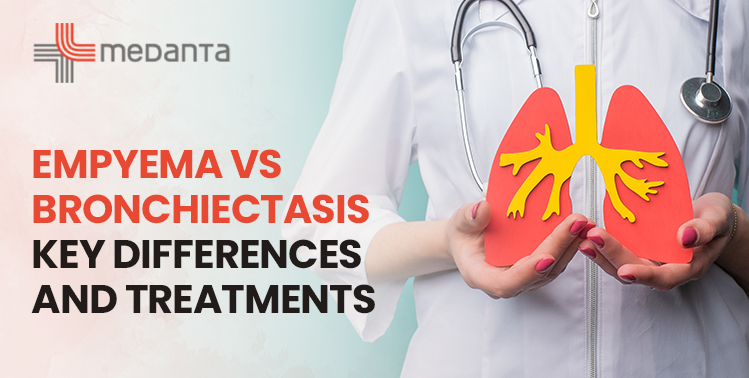CH Baktawar Singh Rd, Medicity, Islampur Colony, Sector 38, Gurugram, Haryana 122001

21 July, 2025
adminWhen it comes to chronic respiratory illnesses, empyema and bronchiectasis are two conditions that often get confused due to their overlapping symptoms and effects on lung function. Both are serious medical conditions that affect the lungs and can lead to long-term complications if not properly managed. However, they are fundamentally different in their causes, progression, and treatment approaches.
In this blog, we’ll break down what each condition is, explore their symptoms and causes, highlight the key differences, and discuss available treatment options. Whether you’re a patient, a caregiver, or someone simply trying to understand more about lung health, this guide will offer clear and helpful insights.
Empyema is a condition where pus accumulates in the pleural space, the area between the lungs and the chest wall. It usually develops as a complication of pneumonia or other infections in the lungs. When bacteria or other pathogens invade the pleural space, the body responds by sending white blood cells to fight the infection. This process leads to the formation of pus, which can put pressure on the lungs and impair breathing.
Doctors typically empyema diagnose using imaging tools like:
Bronchiectasis is a chronic lung disease where the bronchial tubes (airways) become permanently widened and damaged. This structural damage makes it difficult to clear mucus effectively, leading to repeated infections and blockages in the lungs. Over time, the lungs become inflamed and scarred, further compromising respiratory function.
Unlike empyema, which is usually acute and caused by infection, bronchiectasis is typically a long-term condition that develops gradually.
Diagnosis usually involves:
The main goal of empyema treatment is to drain the pus and treat the infection. Here’s how it’s usually managed:
Once a bacterial cause is confirmed, intravenous (IV) antibiotics are administered based on the organism identified from pleural fluid. Treatment usually lasts several weeks.
If empyema doesn’t improve with antibiotics and drainage, more invasive options are considered:
Bronchiectasis requires a comprehensive, long-term management plan to control symptoms and prevent progression.
These help to remove mucus from the lungs and reduce the risk of infection.
People with bronchiectasis should stay up to date with flu, COVID-19, and pneumococcal vaccines to prevent respiratory infections.
In rare, localized cases where medical treatment fails, surgery to remove the affected part of the lung may be considered.
Structured exercise and education programs improve lung function, stamina, and quality of life.
Yes, they can. In fact, untreated or severe bronchiectasis can increase the risk of lung infections, which may lead to complications like empyema. Similarly, if empyema leads to persistent lung damage or scarring, it might contribute to the development of bronchiectasis over time.
This is why early diagnosis and tailored treatment are essential in both conditions to avoid complications and irreversible lung damage.
Being diagnosed with either empyema or bronchiectasis can be overwhelming. The key to managing these conditions effectively lies in ongoing medical care, patient education, and adherence to treatment plans.
For bronchiectasis in particular, lifestyle adjustments can make a huge difference:
Meanwhile, those recovering from empyema should follow up closely with their doctor to ensure full resolution of infection and to monitor for any long-term effects on lung function.
Empyema and bronchiectasis may both affect the lungs, but they do so in fundamentally different ways. While empyema is an acute infection of the pleural space, bronchiectasis is a chronic condition of the airways. According to Dr Harsh Vardhan Puri, understanding the key differences between the two can aid in early recognition, appropriate treatment, and better outcomes.
Whether you or a loved one is navigating a new diagnosis or managing a long-standing condition, remember that knowledge is power. Work closely with your healthcare team, including specialists like Dr Harsh Vardhan Puri, stay informed, and take proactive steps to protect your lung health.
Category : Empyema Treatment
Tags: